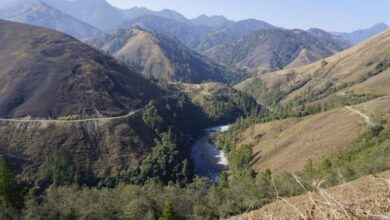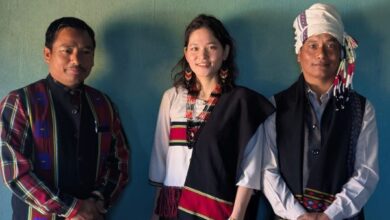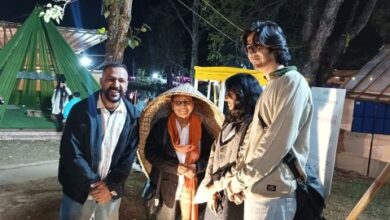Fight is on: Defying age in the dojo
Many in their forties & fifties are training in mixed martial arts at Happy Red Rooster in city to stay fit
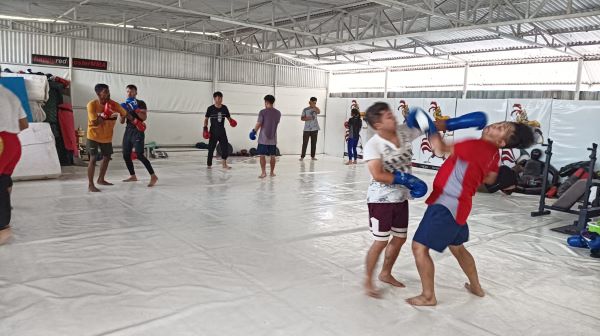
Leone Jyrwa joined mixed martial arts (MMA) classes to regain her flexibility and energy after the pandemic locked down lives. For Dr Raj Konwar, it was mere happenstance. MMA “always fascinated” Andreena Kharumnuid, and she knew she had to delve deeper into the sport.
All three may have different reasons for joining MMA, considered one of the most aggressive sports in the world, but they share a common trait. They are all in their forties.
The trend of joining MMA after the fighting or competitive age is rising in Shillong, especially post-COVID-19. The growing awareness about a healthy life is driving people towards the sport. Happy Red Rooster (HRR), a city-based MMA institution that was formed in June 2016, is a go-to place for late starters.
“We welcome people in the age group of 40-50. And we are happy to have them. They are an integral part of the team. Even the younger members show them a little extra respect, not just for being older but for being older and being able to do what they do at a more advanced age,” said Reuben LC Lulam, one of the jiu-jitsu coaches at HRR.
The 46-year-old coach said he too started late. “What I do is not so much coaching but sharing what I have learnt along the way with those interested,” he added.
What is MMA

MMA is among the most popular sports worldwide, especially among the youth. “It is more appealing to the crowd for the violence and energy. Even I enjoy the sport though my personal favourite is jiujitsu,” said Darren Kharshandy, the 26-year-old coach at HRR.
Though MMA’s popularity grew in the last three decades, the history of the cage fight concept can be traced to ancient times. The Leitai in ancient China and Pankration in Greece were highly popular. The latter even appeared in the Olympics around 648 BC. Ancient Indian history mentions unarmed combat, such as malla yuddha, or combat wrestling.
MMA started shaping in its modern form in the early 20th century. However, it was noticed in the world arena in the 1990s when the Ultimate Fighting Championship (UFC) was organised in America. The UFC played a crucial role in laying down guidelines for MMA. By the early 21st century, regulatory bodies worldwide set the standards defining the modern form of the sport.
WATCH OUR YOUTUBE CHANNEL
As the name suggests, MMA incorporates boxing, wrestling, jiujitsu, judo, Muay Thai and other unarmed fighting techniques. At HRR, the MMA technique is mainly jiujitsu-based. Though there is no upper age limit for competition, fighters join the league young because of more stamina and better agility.
“Realistically, competing in MMA will be too brutal for people above the age of 50 as the risk of injuries is too great. But jiujitsu, which is a part of MMA, is relatively safe,” said Isaiah Kharmawphlang, the 44-year-old coach of jiujitsu.
Why MMA
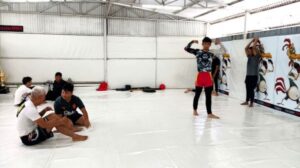
Besides being a sought-after sport among youngsters, MMA has gained popularity among people of advanced age. The sport helps gain fitness and agility and teaches the basics of self-defence. HRR has eight members who are above the fighting age.
Jyrwa, 46, joined HRR two years back. She opted for personal training for boxing and jiujitsu under Kharshandy. Her goal is fitness. “I was always active until the pandemic hit and we had to lock ourselves in our houses. I loved walking and would keep myself busy with household chores. But all those stopped. The thyroxine problem added to the woes. I would feel tired all the time. It was then that I found out about Red Rooster,” said Jyrwa.
Konwar started MMA at 47 when his friends brought him to Red Rooster. As a cycling enthusiast, he was always into fitness. He too started with personal training under wrestling coach Echwa Phawa and then moved on to the general classes.
“As we grow older, our mobility reduces. So, we should always be involved in physical activity. MMA is a sport and any sport is a part of life. I am a cyclist but chose MMA because it provides a wholesome experience. The sport may seem visceral but also nurtures the ability to think in a highly stressful situation,” said Konwar, a psychiatrist by profession.
Some like 43-year-old Kharumnuid have chosen MMA to sharpen their related sporting skills. She was into karate, taekwondo and arm wrestling before joining HRR. She said she felt healthier after two years of MMA training and gained more strength and stamina.
Kharumnuid is among the most talented fighters at HRR in the age group. She is always ready to notch up the challenge and displays incredible sinew while grappling with fighters younger than her. When asked about competition, she said she never thought about it seriously.
Karthik, a state-level boxing champion, joined HRR to continue with his core sport. But he got drawn towards jiujitsu and became a state champion at 36.
“At HRR, I was introduced to kickboxing and grappling. But I found jiujitsu to be a sport for my age. I could control the pace of training and juggle a full-time job. Moreover, it is a creative sport and every session is a challenge,” said Karthik, who joined HRR in 2021.
Phawa joined HRR five years ago as a student and became its wrestling coach in 2020. The 27-year-old national champion said he has a 64-year-old student “who is in perfect health condition”.
“I also know someone who is 74 and does jiujitsu. So, age is not a factor as long as you can train. Doctor (Raj Konwar) was my first client and he mastered the techniques fast,” said Phawa.
A member of HRR, Jerose Lamare, won silver at ADCC India at 43. He trains in boxing, kickboxing, wrestling and BJJ. “What is notable is that he won silver through sheer consistency — showing up every day and training regularly. We are very proud of him,” said Lulam.
MMA for women
MMA can be a sport of choice for women in their forties and inching towards menopause because of its overall benefits. The sport strengthens bones, helps with obesity, and improves cardiovascular and mental health, among others. Apart from this, MMA is also a great self-defence technique for women of all ages.
“BJJ (Brazilian jiu-jitsu) is a lot of fun. I wish more women of all ages could get into it. It is such a fun way to gain health and fitness. But this is more of a byproduct; the real ‘take-home’ is the skills we learn,” said 39-year-old Lalliankimi Renthlei, who joined HRR two years ago mainly for well-being.
“Women can learn effective self-defence, physical fitness, stress relief and overall personal growth,” emphasised Ajitabh Goswami, 33, who joined HRR in 2020.
Besides fitness and self-defence, MMA training instils confidence in individuals. The classes also help break the monotony of life, observed Kharshandy, an MMA gold medallist at the national level.
“The dojo has become a place to socialise and meet people of all age groups and from different walks of life. It is a place of zen,” said Kharmawphlang.
(Read: Happy Red Rooster wins four medals at Guwahati event)
Special training?
The older members at HRR are trained with the young fighters unless one opts for personal training. However, the coaches are cautious enough not to burden them. It is advisable to disclose health problems before joining the classes.
“When someone joins the MMA classes, it shows one’s confidence to pursue the sport. So, I do not ask them separately. But if someone says that he or she has knee or back problems, I give them a few drills. I monitor them for a few days, and if required, change the drills,” explained Kharshandy.
Lulam pointed out the need for tweaking training and practice “to suit the level of athleticism or the lack of it”. He also lauded the younger members and coaches for their respectful attitude and expertise in handling ‘older’ students.
“The goal is to improve, to be a better version of oneself at the end of each month and consistently pursue this goal,” he added.
At the same time, the coach emphasised that the training must prioritise technicality, learning the skill and management of pace rather than physicality for older members.
One should also be mindful of complementing the physical training with proper diet and rest, said Renthlei.
(Read: Team Happy Red Rooster wins 3 gold, 2 silver in Aireng tourney in city)
Challenges
The main challenge that late starters face is physical fitness. MMA requires rigorous training and to take up the gauntlet needs confidence. “It’s a young person’s sport, so speed and stamina are a must, which is difficult with age,” said Kharumnuid.
Many prefer jiujitsu at an advanced age because it is a “high intensity but low impact” sport.
“It was perfect for someone as slow, unathletic and arthritic as I am. I have tried going to the gym but got bored too easily… Jiujitsu not only demands physicality, but it is more of a mind game. It requires more brain to overcome brawn,” said Kharmawphlang.
According to Kharshandy, the greatest challenge for a coach is allaying the fear of injury among older members. Many a time, they find it difficult to keep up with the young trainees, but the coaches here suggest they follow their pace and set their own goals.
Those who compete at an advanced age face a steeper challenge to combat with more agile opponents. “The younger competitors are fast. Agile and stronger. So, the challenge for those competing at an advanced age always remains,” said Karthik.
However, Phawa had a word of encouragement for the older members. He observed that most of these trainees are fast learners and could pick up skills without hassle.
Make it happen
True, age is not just a number but it is also not a deterrence to changing the way one looks at life. Choosing MMA at an older age may seem challenging but as Lulam said, “If you are thinking about training, you are likely able to. Go for it now. It will only improve your life.”
Getting on to the dojo means setting the bar higher for oneself, and at the same time, inspiring the youngsters.
“I meet many people who say that they are too old to start training in combat sports. I would want them to meet the older athletes in our dojo. You would never find out your true potential without giving it a try. Recklessness comes with youth but with age comes wisdom. We have learnt to train safely and listen to our body and the feedback it gives,” said Kharmawphlang, who firmly believes that physical injuries are better than lifestyle diseases.
The fight is always on if one is ready to face challenges.
~ Team Sunday Monitor


